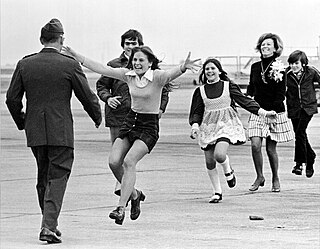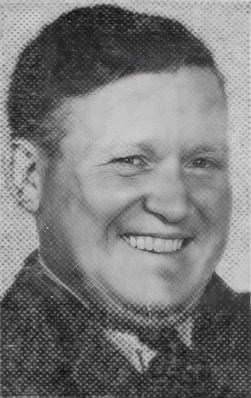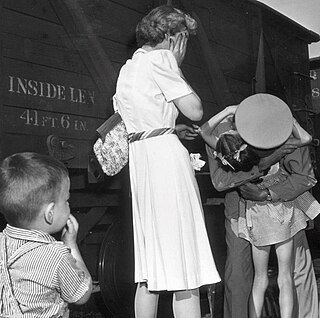Related Research Articles

Toshio Sakai was a Japanese photographer for United Press International. He was the first winner of the Pulitzer Prize for Feature Photography.

The Pulitzer Prizes for 1980 were announced on April 14, 1980. A total of 1,550 entries were submitted for prizes in 19 categories of journalism and the arts. Finalists were chosen by expert juries in each category, and winners were then chosen by the 16-member Pulitzer Prize Board, presided over by Clayton Kirkpatrick. For the first time in the Prizes' history, juries were asked to name at least three finalists in each category, and the finalists were announced in addition to the winners. Each prize carried a $1,000 award, except for the Public Service prize, which came with a gold medal.
Larry C. Price is an American photojournalist who has won two Pulitzer Prizes. In 1981, he won the Pulitzer Prize in Spot News Photography, recognizing images from Liberia published by the Fort Worth Star-Telegram. In 1985, he won the Pulitzer Prize for Feature Photography for images from war-torn Angola and El Salvador published by The Philadelphia Inquirer.
The Mercury is a daily newspaper published in Pottstown, Pennsylvania, United States.

Stanley Joseph Forman is an American photojournalist, who won the Pulitzer Prize for Spot News Photography two years in a row while working at the Boston Herald American.

Burst of Joy is a Pulitzer Prize-winning photograph by Associated Press photographer Slava "Sal" Veder, taken on March 17, 1973, at Travis Air Force Base in Solano County, California, United States involving Lt Col Robert L. Stirm and his family.

Moneta J. Sleet Jr. was an American press photographer best known for his work as a staff photographer for Ebony magazine. In 1969 he was awarded the Pulitzer Prize for Feature Photography for his photograph of Coretta Scott King, Martin Luther King Jr.'s widow, at her husband's funeral. Sleet was the first African-American man to win the Pulitzer, and the first African American to win the award for journalism. He died of cancer in 1996 at the age of 70.

Milton E. "Pete" Brooks was the winner of the first Pulitzer Prize for Photography in 1942.
Neal Hirsh Ulevich is an American photographer. He won a Pulitzer Prize in 1977 for "photographs of disorder and brutality in the streets of Bangkok".
Thomas J. Kelly III, born in Hackensack, New Jersey, is an American, Pulitzer prize-winning photojournalist. Based in greater Philadelphia, he has worked as a freelancer for electronic and print outlets since 1995. Kelly joined the staff of The Mercury in Pottstown, Pennsylvania in 1974, where he won the 1979 Pulitzer prize for spot news photography; he left The Mercury in 1989.
Dick L. Swanson is an American photographer renowned for his work, particularly as a war photographer with numerous published photographs in the United States.

The Life of the Mind in America: From the Revolution to the Civil War is a nonfiction history book by Perry Miller. It won the 1966 Pulitzer Prize for History.
Philip P. Kerby (1911–1993) was an American editorial writer who worked for the Los Angeles Times from 1971 to 1985. He won the Pulitzer Prize for editorial writing in 1976.
James Kenneth Ward Atherton was a press photographer active in Washington D.C. for over forty years.

Evelyn Straus was an American photojournalist and the first woman employed as a photographer at the Daily News in New York City. She was one of the first women admitted to the National Press Photographers Association in 1945 and joined the Press Photographers Association of New York City in 1952 as soon as they allowed women as members. During her career, she was a finalist for the Pulitzer Prize for Photography and had work featured at the Museum of Modern Art.

Faith and Confidence is a Pulitzer Prize–winning photograph of two-year-old Allan Weaver asking police officer Maurice Cullinane a question. The 1957 image was captured by photographer William C. Beall in Washington, D.C.

William C. Beall was an American Pulitzer-winning photographer. In 1957 he captured a photograph of two-year-old Allan Weaver and police officer Maurice Cullinane which he titled Faith and Confidence. The image won the 1958 Pulitzer Prize for Photography.

Homecoming is a 1943 photograph of an American soldier returning from active service in World War II. The image was captured by Earle Bunker and it won the 1944 Pulitzer Prize for Photography. The image also won a national Associated Press news photo contest and it was featured in Life, Time and Newsweek.

Tragedy by the Sea, also known as Cruel Waves, is a photo showing a young couple, John and Lillian McDonald, standing together beside the Pacific Ocean in Hermosa Beach, California, United States. The image was captured in April 1954 by Los Angeles Times photographer John L. Gaunt. A few minutes before the image was taken, the couple's nineteen-month-old son Michael had disappeared. The photo won the 1955 Pulitzer Prize for Photography and an Associated Press Award.

Ford Strikers Riot is a 1941 photograph which shows a strikebreaker getting beaten by United Auto Workers (UAW) strikers. Photographer Milton Brooks captured the image and it won the first Pulitzer Prize for Photography in 1942.
References
- ↑ ID: 500088578. Union List of Artist Names Online. The J. Paul Getty Trust. Retrieved 2013-10-26.
- ↑ "Pulitzer Prizes". www.pulitzer.org. Retrieved 2016-04-23.
- 1 2 Fischer, Heinz Dietrich; Fischer, Erika J. (2000-01-01). Press Photography Awards, 1942-1998: From Joe Rosenthal and Horst Faas to Moneta Sleet and Stan Grossfeld. Walter de Gruyter. ISBN 9783598301841.
- ↑ "The Great American Photographer: Matthew Lewis". Our State: Celebrating North Carolina. January 2011. Retrieved March 12, 2016.
- 1 2 3 "Jerry Howell Lecture Series: Pulitzer Prize Winner Matthew Lewis to Speak at Randolph Community College Jan. 21". www.randolph.edu. Retrieved 2016-03-03.
- ↑ Deneesha Edwards (February 11, 2009). "Famous photographer takes DCCC students on journey". The Davidson Dispatch. Davidson County Community College.
- ↑ "Black Photographer To Be Honored By Intl Civil Rights Museum". BlackRadioNetwork. Retrieved 2016-03-03.
- ↑ Fischer, Heinz-D.; Fischer, Erika J. (2003-01-01). Complete Historical Handbook of the Pulitzer Prize System 1917-2000: Decision-Making Processes in all Award Categories based on unpublished Sources. Walter de Gruyter. ISBN 9783110939125.
- ↑ Fischer, Heinz Dietrich; Fischer, Erika J. (2000-01-01). Press Photography Awards, 1942-1998: From Joe Rosenthal and Horst Faas to Moneta Sleet and Stan Grossfeld. Walter de Gruyter. ISBN 9783598301841.
- ↑ "INTERNATIONAL CIVIL RIGHTS CENTER & MUSEUM TO HONOR MATTHEW LEWIS" (PDF). June 22, 2010. Retrieved March 12, 2016.